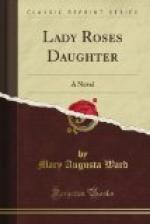The Duchess, full of nervousness, ran up the steps, put in the key herself, and threw open the door. An elderly Scotchwoman, the caretaker, appeared from the back and stood waiting to show them over.
“Oh, Julie, perhaps it’s too queer and musty!” cried the Duchess, looking round her in some dismay. “I thought, you know, it would be a little out-of-the-way and quaint—unlike other people—just what you ought to have. But—”
“I think it’s delightful,” said Julie, standing absently before a case of stuffed birds, somewhat moth-eaten, which took up a good deal of space in the little hall. “I love stuffed birds.”
The Duchess glanced at her uneasily. “What is she thinking about?” she wondered. But Julie roused herself.
“Why, it looks as though everything here had gone to sleep for a hundred years,” she said, gazing in astonishment at the little hall, with its old clock, its two or three stiff hunting-pictures, its drab-painted walls, its poker-work chest.
And the drawing-room! The caretaker had opened the windows. It was a mild March day, and there were misty sun-gleams stealing along the lawns of Cureton House. None entered the room itself, for its two semi-circular windows looked north over the gardens. Yet it was not uncheerful. Its faded curtains of blue rep, its buff walls, on which the pictures and miniatures in their tarnished gilt frames were arranged at intervals in stiff patterns and groups; the Italian glass, painted with dilapidated Cupids, over the mantel-piece; the two or three Sheraton arm-chairs and settees, covered with threadbare needle-work from the days of “Evelina”; a carpet of old and well-preserved Brussels—blue arabesques on a white ground; one or two pieces of old satin-wood furniture, very fine and perfect; a heavy centre-table, its cloth garnished with some early Victorian wool-work, and a pair of pink glass vases; on another small table close by, of a most dainty and spindle-legged correctness, a set of Indian chessmen under a glass shade; and on another a collection of tiny animals, stags and dogs for the most part, deftly “pinched” out of soft paper, also under glass, and as perfect as when their slender limbs were first fashioned by Cousin Mary Leicester’s mother, somewhere about the year that Marie Antoinette mounted the scaffold. These various elements, ugly and beautiful, combined to make a general effect—clean, fastidious, frugal, and refined—that was, in truth, full of a sort of acid charm.
“Oh, I like it! I like it so much!” cried Julie, throwing herself down into one of the straight-backed arm-chairs and looking first round the walls and then through the windows to the gardens outside.
“My dear,” said the Duchess, flitting from one thing to another, frowning and a little fussed, “those curtains won’t do at all. I must send some from home.”
“No, no, Evelyn. Not a thing shall be changed. You shall lend it me just as it is or not at all. What a character it has! I taste the person who lived here.”




